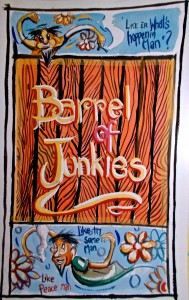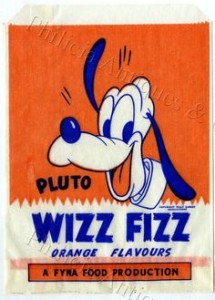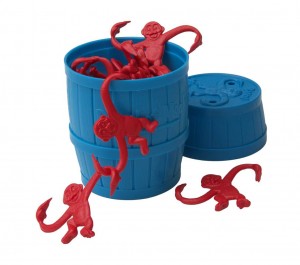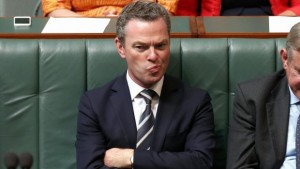Dear reader, after detailed analysis of the most recent presidential election debate between Hillary ‘Status Quo’ and Donald ‘Raving Looney’, we have decided that politics is a bit like Spock’s analysis of Aliens; “ It’s life Jim, but not as we know it”. Good thing then that the Turnbull government has committed itself to doing nothing. EVER! That’s a comforting thought, whilst allowing the market to do whatever it likes with healthcare, education, and ensuring that several generations down the line will never ever own a house. Never in the history of Australian society have so many of the likes of generation X, Y, and Z, yearned for their parents to die. So as an alternative let’s return to a more idealistic era, as we trawl once again into the toys that almost made it. An era when almost anything was possible, and governments, (most of the time) led for the good of society.

Attractive ‘Barrel of Junkies” label. c. 1973
Taking a cue from the war on drugs, announced by the Nixon administration in the early 70’s the federal government decided as part of its; ‘break the cycle initiative’ to encourage deep seated changes to the attitudes prevalent, post flower power era that drugs were O.K . The screening of the provocative, ‘No Roses for Michael’, and the anti cancer council’s first forays into the root use of teenage drug exposure led to a variety of initiatives designed to combat drug use at the ‘pointy end’, amongst teenagers. Then seen as having a predilection for Marlboro, Mcwhilliams Cream Sherry Coolabah and Brandivino which were believed to be precursors for very hard drug use. The drugs strategy was simple, focus on the everyday items that the public don’t perceive as drugs and in so doing create an awareness. Once the awareness had been established, an informed programme of drug identification and dangers would be consolidated in education, print media, and on television and radio.
At first the initiative was a startling success. Sales of Kool Aid, and Cottees’ Lemon Crush soared as parents moved away from Tab, Fanta, and Tarax, for less sugary drinks. Sugar being singled out as a damaging precursor to drug addiction. Inadvertent victims of the growing awareness were sales slumps of Whizz Fizz, licorice cigars, Footy cards (the Scanlens gum) and Sherbert bombs. The adverts suggested that any thing delicately wrapped enclosing a white powdered substance was a precursor to high level drug use. Parents, frightened by the possibilities of such items being encouraged amongst children acted responsibly. By mid 1972, sales of the formatted booklet, ‘Don’t dig drugs Man’, were impressive. Designed as a counter to the enhanced stardom of T Rex, Bowie, and the glam era the booklets were tastefully designed by the government printer in Safari Yellow and Mission Brown, popular colours at the time.
Then, weeks after the launch of the drugs initiative, sales and interest began to fail. All the heightened warnings and dangers went unheeded. The population was at risk of being over exposed to the shock tactic. School hall lectures became filled with bored listless students falling asleep at the sound of appalling statistics, and rather than discourage, the reaction was one of collective disinterest which soon turned to a counter cultural allure. Nothing it seemed could be done to stop the scourge of drugs.
Then in October 1973, came a breakthrough. A games conference held adjacent the international drugs addiction forum held at the Melbourne Festival Hall, provided the catalyst. At that time visiting professor and world expert on drug addiction professor, Fillemup Withwead, came across the very popular ‘Barrel of Monkeys’. He watched fascinated as a convener encouraged a group of non drug taking school age children by engaging the complete set of 58 monkeys in a continuous chain. In an instant the idea was Born, ‘Barrel of Junkies’, became a hit, ‘Barrel of’ established the junkie, rather than as a cool, street life, alternative icon into a shambolic figure of fun. Drug use declined overnight, as ‘Barrel of’, held sway across living rooms across Australia. The game was simple, a plastic barrel and board, identical to “Monkeys” in which the junkies, were thrown out onto the street. The purpose to lift the junkies and throw them off the street and ‘into the can’. The street was a simple thoroughfare, with sections labelled School, Kindergarten, Fish and Chip Shop, Newsagent, Garage, Town Hall, Local Pool, Library, RSL and Pool Hall. The majority of the junkies were placed in the pool hall, and any that fell onto the street were deducted from the score. The ‘can’ being the open ended Barrel. The exterior of the barrel was an innovative departure from the standard barrel of monkeys, with spaced out junkies, and iconic exterior designs of flowers, swirls and the phrases, “far out’ ‘groovy’. ‘Space man’, and ‘Stoned’. The junkies came in several colours, ‘tangerine’, ‘groovatronic green’, and ‘deep space’ , and were clearly labelled toxic, as some children inspired by the concept had smoked them and suffered irretrievable lung damage. When released in the summer of 74. they came in a plain box with a parental warning, and in spite of complaints from the Australasian Family Association (AFA), Choice, the Christian Religious Education Excitement Party, (CREEP) Purity Unity Society, (PUS) the barrels were freely available in newsagents, toy stores and selected service stations.
Interest in the product declined in the late 80‘s with the onset of acid house, exctasy and ice, and the product was withdrawn from sale and on-sold to Kentucky fried as a giveaway for every purchase of the KFC Big Barrel. This ceased when a family in their eagerness to consume the KFC big Bucket, swallowed the contents of a barrel of junkies and suffered irreversible internal failure. The medical verdict pointed to the elongated curved hands and fingers of the junkies ripping into membrane walls and destroying arteries . ‘Fingerer sticckin Food’ (Pronounced as in ‘Hood”). KFC withdrew the product and a out of court settlement was made to the relatives of the deceased. At the time of writing only one complete set remains and is the property of the Minister for Innovation the Rt Hon Christopher Pyne, who may resurrect the product rebadged as a ‘Barrel full of Flunkies’ designed to assist with the emergence of a new strata of bureacrats to administer the ‘Ideas Boom’.



